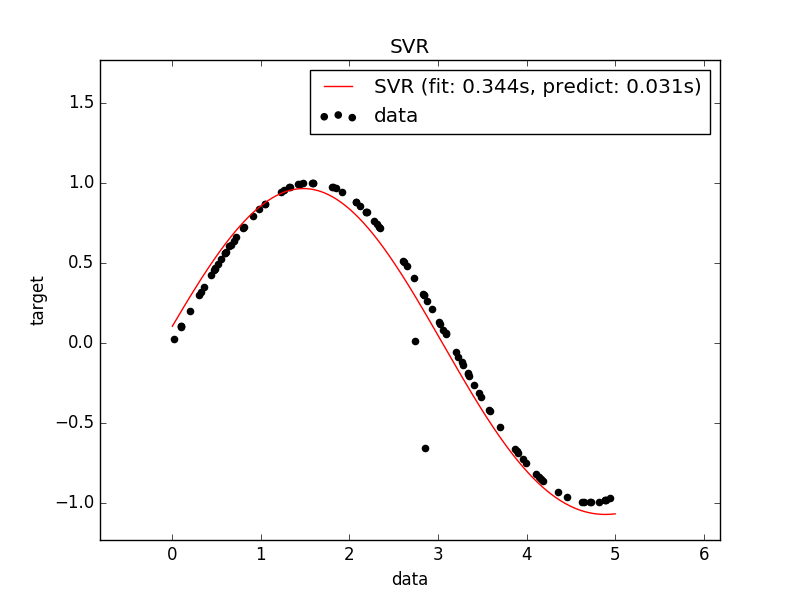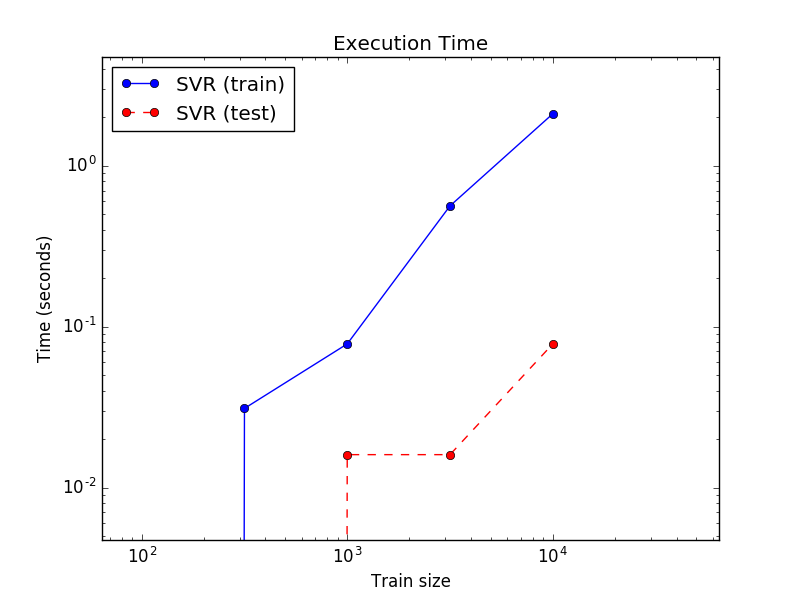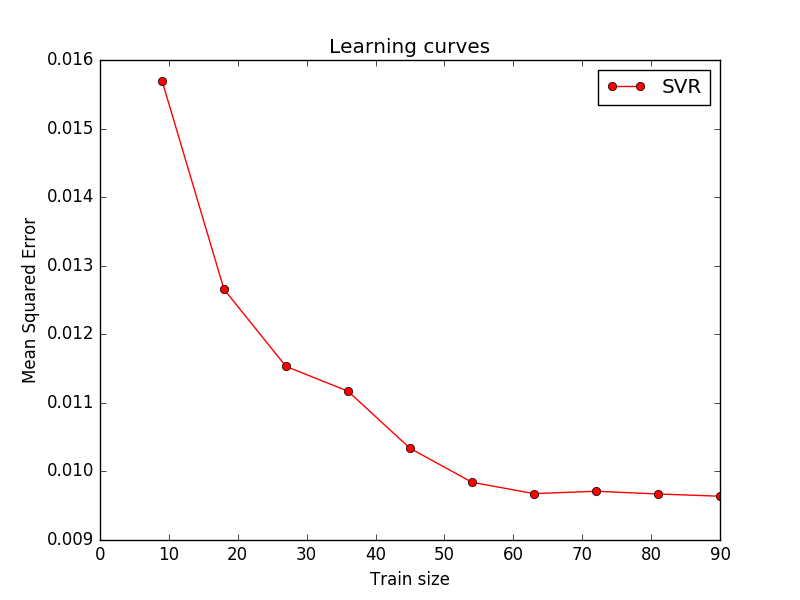溫馨提示×
您好,登錄后才能下訂單哦!
點擊 登錄注冊 即表示同意《億速云用戶服務條款》
您好,登錄后才能下訂單哦!
scikit-learn是python的第三方機器學習庫,里面集成了大量機器學習的常用方法。例如:貝葉斯,svm,knn等。
scikit-learn的官網 : http://scikit-learn.org/stable/index.html點擊打開鏈接
SVR是支持向量回歸(support vector regression)的英文縮寫,是支持向量機(SVM)的重要的應用分支。
scikit-learn中提供了基于libsvm的SVR解決方案。
PS:libsvm是臺灣大學林智仁教授等開發設計的一個簡單、易于使用和快速有效的SVM模式識別與回歸的軟件包。
我們自己隨機產生一些值,然后使用sin函數進行映射,使用SVR對數據進行擬合
from __future__ import division
import time
import numpy as np
from sklearn.svm import SVR
from sklearn.model_selection import GridSearchCV
from sklearn.model_selection import learning_curve
import matplotlib.pyplot as plt
rng = np.random.RandomState(0)
#############################################################################
# 生成隨機數據
X = 5 * rng.rand(10000, 1)
y = np.sin(X).ravel()
# 在標簽中對每50個結果標簽添加噪聲
y[::50] += 2 * (0.5 - rng.rand(int(X.shape[0]/50)))
X_plot = np.linspace(0, 5, 100000)[:, None]
#############################################################################
# 訓練SVR模型
#訓練規模
train_size = 100
#初始化SVR
svr = GridSearchCV(SVR(kernel='rbf', gamma=0.1), cv=5,
param_grid={"C": [1e0, 1e1, 1e2, 1e3],
"gamma": np.logspace(-2, 2, 5)})
#記錄訓練時間
t0 = time.time()
#訓練
svr.fit(X[:train_size], y[:train_size])
svr_fit = time.time() - t0
t0 = time.time()
#測試
y_svr = svr.predict(X_plot)
svr_predict = time.time() - t0
然后我們對結果進行可視化處理
#############################################################################
# 對結果進行顯示
plt.scatter(X[:100], y[:100], c='k', label='data', zorder=1)
plt.hold('on')
plt.plot(X_plot, y_svr, c='r',
label='SVR (fit: %.3fs, predict: %.3fs)' % (svr_fit, svr_predict))
plt.xlabel('data')
plt.ylabel('target')
plt.title('SVR versus Kernel Ridge')
plt.legend()
plt.figure()

##############################################################################
# 對訓練和測試的過程耗時進行可視化
X = 5 * rng.rand(1000000, 1)
y = np.sin(X).ravel()
y[::50] += 2 * (0.5 - rng.rand(int(X.shape[0]/50)))
sizes = np.logspace(1, 4, 7)
for name, estimator in {
"SVR": SVR(kernel='rbf', C=1e1, gamma=10)}.items():
train_time = []
test_time = []
for train_test_size in sizes:
t0 = time.time()
estimator.fit(X[:int(train_test_size)], y[:int(train_test_size)])
train_time.append(time.time() - t0)
t0 = time.time()
estimator.predict(X_plot[:1000])
test_time.append(time.time() - t0)
plt.plot(sizes, train_time, 'o-', color="b" if name == "SVR" else "g",
label="%s (train)" % name)
plt.plot(sizes, test_time, 'o--', color="r" if name == "SVR" else "g",
label="%s (test)" % name)
plt.xscale("log")
plt.yscale("log")
plt.xlabel("Train size")
plt.ylabel("Time (seconds)")
plt.title('Execution Time')
plt.legend(loc="best")

################################################################################
# 對學習過程進行可視化
plt.figure()
svr = SVR(kernel='rbf', C=1e1, gamma=0.1)
train_sizes, train_scores_svr, test_scores_svr = \
learning_curve(svr, X[:100], y[:100], train_sizes=np.linspace(0.1, 1, 10),
scoring="neg_mean_squared_error", cv=10)
plt.plot(train_sizes, -test_scores_svr.mean(1), 'o-', color="r",
label="SVR")
plt.xlabel("Train size")
plt.ylabel("Mean Squared Error")
plt.title('Learning curves')
plt.legend(loc="best")
plt.show()

看見了熟悉的LOSS下降圖,我仿佛又回到了學生時代。。
以上就是本文的全部內容,希望對大家的學習有所幫助,也希望大家多多支持億速云。
免責聲明:本站發布的內容(圖片、視頻和文字)以原創、轉載和分享為主,文章觀點不代表本網站立場,如果涉及侵權請聯系站長郵箱:is@yisu.com進行舉報,并提供相關證據,一經查實,將立刻刪除涉嫌侵權內容。